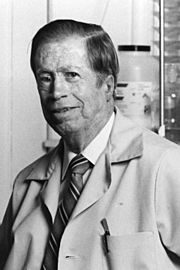Robert Bruce Merrifield facts for kids
Quick facts for kids
Robert Bruce Merrifield
|
|
|---|---|
 |
|
| Born | July 15, 1921 |
| Died | May 14, 2006 (aged 84) |
| Nationality | American |
| Alma mater | UCLA (Ph.D., 1949) |
| Known for | solid phase peptide synthesis |
| Awards | Albert Lasker Award for Basic Medical Research (1969) Gairdner Foundation International Award (1970) Nobel Prize in Chemistry (1984) Golden Plate Award of Academy of Achievement(1985) Glenn T. Seaborg Medal (1993) Chemical Pioneer Award (1993) |
| Scientific career | |
| Fields | Biochemistry |
| Institutions | UCLA Rockefeller University |
| Thesis | Microbiological Studies in Pyrimidines (1949) |
| Doctoral advisor | Max S. Dunn |
Robert Bruce Merrifield was an American scientist who made a huge discovery! He won the Nobel Prize in Chemistry in 1984. His invention, called solid phase peptide synthesis, changed how scientists create important tiny molecules called peptides.
Contents
Early Life and Education
Robert Bruce Merrifield was born in Fort Worth, Texas, on July 15, 1921. He was the only son of George and Lorene Merrifield. In 1923, his family moved to California. He went to many different schools there. He graduated from Montebello High School in 1939. It was in high school that he became very interested in chemistry and astronomy.
After high school, he studied for two years at Pasadena Junior College. Then, he transferred to the University of California at Los Angeles (UCLA). After earning his degree in chemistry, he worked for a year at a research foundation. He helped with experiments on how animals grow using special diets. These experiments showed that certain important molecules, called amino acids, must be present at the same time for growth to happen.
He later returned to UCLA for graduate school. He studied biochemistry and worked on ways to measure certain chemicals called pyrimidines. The day after he finished his Ph.D. on June 19, 1949, he married Elizabeth Furlong. The very next day, they moved to New York City to work at the Rockefeller Institute for Medical Research.
A Groundbreaking Scientific Career
At the Rockefeller Institute, which later became Rockefeller University, Dr. Merrifield worked with Dr. D.W. Woolley. Their research involved studying growth factors, which are substances that help living things grow. These studies made it clear that scientists needed a better way to create peptides. Peptides are like small proteins, made of chains of amino acids.
This need led Dr. Merrifield to a brilliant idea in 1959: solid phase peptide synthesis (SPPS). In 1963, he wrote a famous paper in the Journal of the American Chemical Society. In this paper, he explained his new method. This article is one of the most important papers ever published in that journal.
Synthesizing Important Molecules
In the mid-1960s, Dr. Merrifield's lab used his new method to create several important molecules. These included bradykinin, angiotensin, and insulin. In 1969, he and his colleague Bernd Gutte achieved something amazing. They were the first to create an enzyme called ribonuclease A. This was a huge step because it proved that enzymes are made of chemicals.
Impact of Solid Phase Peptide Synthesis
Dr. Merrifield's method greatly helped progress in many science fields. These include biochemistry, pharmacology (the study of medicines), and medicine. His invention made it possible for scientists to easily explore how enzymes, hormones, and antibodies work. This technique continued to be developed in his lab.
The successful creation of ribonuclease A showed something very important. It proved that the simple, straight chain of amino acids in a peptide or protein directly decides its complex 3D shape. This means that information coded in one dimension (the amino acid sequence) can determine a molecule's three-dimensional structure.
His solid phase synthesis method has also been used to create other important molecules. These include nucleotides (the building blocks of DNA) and saccharides (sugars).
Personal Life and Legacy
Robert and Elizabeth Merrifield had six children: James, Nancy, Betsy, Cathy, Laurie, and Sally. After their children grew up, his wife Elizabeth, who was also a biologist, joined his lab. She worked there for more than 23 years.
After a long illness, R. Bruce Merrifield passed away on May 14, 2006. He was 84 years old and died at his home in Cresskill, New Jersey. He was survived by his wife Libby, their six children, and sixteen grandchildren. Libby passed away later, on September 13, 2017.
Dr. Merrifield's work continues to be incredibly important in science today.
See also

- In Spanish: Robert Bruce Merrifield para niños

